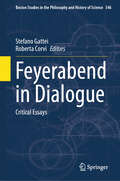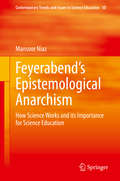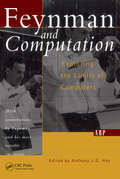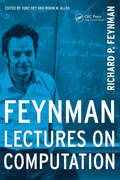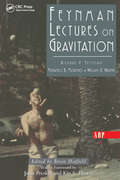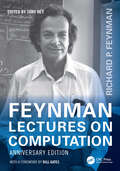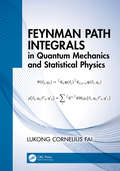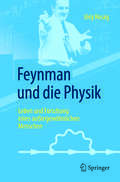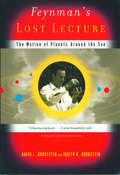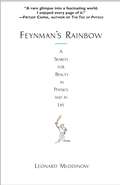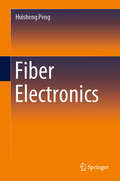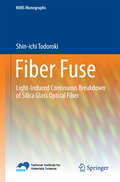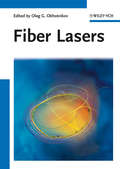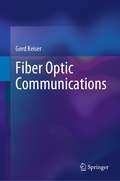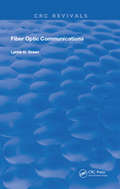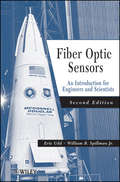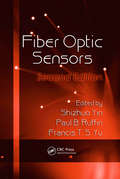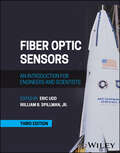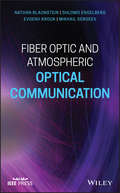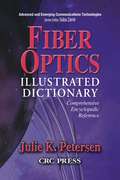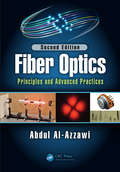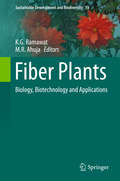- Table View
- List View
Feyerabend in Dialogue: Critical Essays (Boston Studies in the Philosophy and History of Science #346)
by Stefano Gattei Roberta CorviThis book offers innovative historical scholarship on Feyerabend’s take on topics such as realism, empiricism, pluralism, materialism, and incommensurability. In addition to discussing certain debates in the philosophy of physics, it also considers the ways in which Feyerabend’s thought can contribute to contemporary debates in science and public policy. It does so by including questions about the nature of scientific methodology, the role of science in society, the public understanding of science, scientism, and the role of expertise in public policy. The chapters provide readers with a comprehensive overview of the topics that Feyerabend engaged with throughout his career, showing both the breadth and the depth of his thought. Though of great value to academics in philosophy of science, it is also accessible and appealing to non-academic audiences with a general interest in science.
Feyerabend’s Epistemological Anarchism: How Science Works and its Importance for Science Education (Contemporary Trends and Issues in Science Education #50)
by Mansoor NiazThis book argues that the traditional image of Feyerabend is erroneous and that, contrary to common belief, he was a great admirer of science. It shows how Feyerabend presented a vision of science that represented how science really works. Besides giving a theoretical framework based on Feyerabend´s philosophy of science, the book offers criteria that can help readers to evaluate and understand research reported in important international science education journals, with respect to Feyerabend’s epistemological anarchism. The book includes an evaluation of general chemistry and physics textbooks. Most science curricula and textbooks provide the following advice to students: Do not allow theories in contradiction with observations, and all scientific theories must be formulated inductively based on experimental facts. Feyerabend questioned this widely prevalent premise of science education in most parts of the world, and in contrast gave the following advice: Scientists can accept a hypothesis despite experimental evidence to the contrary and scientific theories are not always consistent with all the experimental data. No wonder Feyerabend became a controversial philosopher and was considered to be against rationalism and anti-science. Recent research in philosophy of science, however, has shown that most of Feyerabend´s philosophical ideas are in agreement with recent trends in the 21st century. Of the 120 articles from science education journals, evaluated in this book only 9% recognized that Feyerabend was presenting a plurality of perspectives based on how science really works. Furthermore, it has been shown that Feyerabend could even be considered as a perspectival realist. Among other aspects, Feyerabend emphasized that in order to look for breakthroughs in science one does not have to be complacent about the truth of the theories but rather has to look for opportunities to “break rules” or “violate categories.” Mansoor Niaz carefully analyses references to Feyerabend in the literature and displays the importance of Feyerabend’s philosophy in analyzing, historical episodes. Niaz shows through this remarkable book a deep understanding to the essence of science. - Calvin Kalman, Concordia University, Canada In this book Mansoor Niaz explores the antecedents, context and features of Feyerabend’s work and offers a more-nuanced understanding, then reviews and considers its reception in the science education and philosophy of science literature. This is a valuable contribution to scholarship about Feyerabend, with the potential to inform further research as well as science education practice.- David Geelan, Griffith University, Australia
Feynman And Computation
by Anthony HeyRichard P. Feynman made profoundly important and prescient contributions to the physics of computing, notably with his seminal articles ?There's Plenty of Room at the Bottom? and ?Simulating Physics with Computers.? These two provocative papers (both reprinted in this volume) anticipated, decades before their time, several breakthroughs that have since become fields of science in their own right, such as nanotechnology and the newest, perhaps most exciting area of physics and computer science, quantum computing.The contributors to this book are all distinguished physicists and computer scientists, and many of them were guest lecturers in Feynman's famous CalTech course on the limits of computers. they include Charles Bennett on Quantum Information Theory, Geoffrey Fox on Internetics, Norman Margolus on Crystalline Computation, and Tommaso Toffoli on the Fungibility of Computation.Both a tribute to Feynman and a new exploration of the limits of computers by some of today's most influential scientists, Feynman and Computation continues the pioneering work started by Feynman and published by him in his own Lectures on Computation. This new computation volume consists of both original chapters and reprints of classic papers by leaders in the field. Feynman and Computation will generate great interest from the scientific community and provide essential background for further work in this field.
Feynman Diagram Techniques in Condensed Matter Physics
by Radi A. JishiA concise introduction to Feynman diagram techniques, this book shows how they can be applied to the analysis of complex many-particle systems, and offers a review of the essential elements of quantum mechanics, solid state physics and statistical mechanics. Alongside a detailed account of the method of second quantization, the book covers topics such as Green's and correlation functions, diagrammatic techniques, and superconductivity, and contains several case studies. Some background knowledge in quantum mechanics, solid state physics and mathematical methods of physics is assumed. Detailed derivations of formulas and in-depth examples and chapter exercises from various areas of condensed matter physics make this a valuable resource for both researchers and advanced undergraduate students in condensed-matter theory, many-body physics and electrical engineering. Solutions to exercises are made available online.
Feynman Lectures On Computation
by Richard P. FeynmanWhen, in 1984?86, Richard P. Feynman gave his famous course on computation at the California Institute of Technology, he asked Tony Hey to adapt his lecture notes into a book. Although led by Feynman, the course also featured, as occasional guest speakers, some of the most brilliant men in science at that time, including Marvin Minsky, Charles Bennett, and John Hopfield. Although the lectures are now thirteen years old, most of the material is timeless and presents a ?Feynmanesque? overview of many standard and some not-so-standard topics in computer science such as reversible logic gates and quantum computers.
Feynman Lectures On Gravitation (Penguin Press Science Ser.)
by Richard FeynmanThe Feynman Lectures on Gravitation are based on notes prepared during a course on gravitational physics that Richard Feynman taught at Caltech during the 1962-63 academic year. For several years prior to these lectures, Feynman thought long and hard about the fundamental problems in gravitational physics, yet he published very little. These lectures represent a useful record of his viewpoints and some of his insights into gravity and its application to cosmology, superstars, wormholes, and gravitational waves at that particular time. The lectures also contain a number of fascinating digressions and asides on the foundations of physics and other issues.Characteristically, Feynman took an untraditional non-geometric approach to gravitation and general relativity based on the underlying quantum aspects of gravity. Hence, these lectures contain a unique pedagogical account of the development of Einstein's general theory of relativity as the inevitable result of the demand for a self-consistent theory of a massless spin-2 field (the graviton) coupled to the energy-momentum tensor of matter. This approach also demonstrates the intimate and fundamental connection between gauge invariance and the principle of equivalence.
Feynman Lectures on Computation: Anniversary Edition (Frontiers in Physics)
by Richard P. FeynmanThe last lecture course that Nobel Prize winner Richard P. Feynman gave to students at Caltech from 1983 to 1986 was not on physics but on computer science. The first edition of the Feynman Lectures on Computation, published in 1996, provided an overview of standard and not-so-standard topics in computer science given in Feynman’s inimitable style. Although now over 20 years old, most of the material is still relevant and interesting, and Feynman’s unique philosophy of learning and discovery shines through. For this new edition, Tony Hey has updated the lectures with an invited chapter from Professor John Preskill on “Quantum Computing 40 Years Later”. This contribution captures the progress made toward building a quantum computer since Feynman’s original suggestions in 1981. The last 25 years have also seen the “Moore’s law” roadmap for the IT industry coming to an end. To reflect this transition, John Shalf, Senior Scientist at Lawrence Berkeley National Laboratory, has contributed a chapter on “The Future of Computing beyond Moore’s Law”. The final update for this edition is an attempt to capture Feynman’s interest in artificial intelligence and artificial neural networks. Eric Mjolsness, now a Professor of Computer Science at the University of California Irvine, was a Teaching Assistant for Feynman’s original lecture course and his research interests are now the application of artificial intelligence and machine learning for multi-scale science. He has contributed a chapter called “Feynman on Artificial Intelligence and Machine Learning” that captures the early discussions with Feynman and also looks toward future developments. This exciting and important work provides key reading for students and scholars in the fields of computer science and computational physics.
Feynman Path Integrals in Quantum Mechanics and Statistical Physics
by Lukong Cornelius FaiThis book provides an ideal introduction to the use of Feynman path integrals in the fields of quantum mechanics and statistical physics. It is written for graduate students and researchers in physics, mathematical physics, applied mathematics as well as chemistry. The material is presented in an accessible manner for readers with little knowledge of quantum mechanics and no prior exposure to path integrals. It begins with elementary concepts and a review of quantum mechanics that gradually builds the framework for the Feynman path integrals and how they are applied to problems in quantum mechanics and statistical physics. Problem sets throughout the book allow readers to test their understanding and reinforce the explanations of the theory in real situations.Features: Comprehensive and rigorous yet, presents an easy-to-understand approach. Applicable to a wide range of disciplines. Accessible to those with little, or basic, mathematical understanding.
Feynman und die Physik: Leben und Forschung eines außergewöhnlichen Menschen
by Jörg ResagDieses Buch nimmt Sie mit auf eine Reise durch das Leben des Physikers Richard Feynman und beschreibt eindrucksvoll, welche wegweisenden wissenschaftlichen Beiträge der Nobelpreisträger zur Entwicklung der modernen Physik geleistet hat. Feynman war ein Querdenker, der immer versucht hat, den Dingen auf den Grund zu gehen. Dabei entwickelte er eine intuitive Anschauung, die seinesgleichen sucht und die ihn zu einem der großen Vermittler von physikalischen Gesetzen machte. Der Autor fängt diese Entwicklung ein und erklärt sie im Rahmen des Zeitgeistes der modernen Physik.Dabei führt er den Leser nicht nur durch das Leben Feynmans, sondern legt den Schwerpunkt auf die Physik: Welche revolutionären Ideen hatte der Physiker, welchen Beitrag leistete er zur Entwicklung der Quantenmechanik und Quantenfeldtheorie, wie kann man Feynmans Herangehensweisen und seine Physik verstehen? Allgemeinverständlich und anschaulich beschreibt das Buch die Physik Feynmans und lädt den Leser dazu ein, physikalische Hintergründe nachzuvollziehen.Lassen Sie sich von diesem Buch verzaubern und verstehen Sie die Physik des Genies, das 2018 seinen 100jährigen Geburtstag feiern würde.
Feynman's Lost Lecture
by David Goodstein Judith R. Goodstein"Glorious."--Wall Street Journal Rescued from obscurity, Feynman's Lost Lecture is a blessing for all Feynman followers. Most know Richard Feynman for the hilarious anecdotes and exploits in his best-selling books "Surely You're Joking, Mr. Feynman!" and "What Do You Care What Other People Think?" But not always obvious in those stories was his brilliance as a pure scientist--one of the century's greatest physicists. With this book and CD, we hear the voice of the great Feynman in all his ingenuity, insight, and acumen for argument. This breathtaking lecture--"The Motion of the Planets Around the Sun"--uses nothing more advanced than high-school geometry to explain why the planets orbit the sun elliptically rather than in perfect circles, and conclusively demonstrates the astonishing fact that has mystified and intrigued thinkers since Newton: Nature obeys mathematics. David and Judith Goodstein give us a beautifully written short memoir of life with Feynman, provide meticulous commentary on the lecture itself, and relate the exciting story of their effort to chase down one of Feynman's most original and scintillating lectures.
Feynman's Rainbow: A Search for Beauty in Physics and in Life
by Leonard MlodinowAcademic scientist turned Hollywood screen writer, Mlodinow recounts his first year on the faculty at California Technical Institute, beginning in winter 1981, and his interactions there with renowned physicist Richard Feynman during his last years. Annotation (c)2003 Book News, Inc., Portland, OR (booknews.com)
Feynman's Tips on Physics: Reflections, Advice, Insights, Practice
by Richard P. Feynman Michael A GottliebFeynman's Tips on Physics is a delightful collection of Richard P. Feynman's insights and an essential companion to his legendary Feynman Lectures on Physics With characteristic flair, insight, and humor, Feynman discusses topics physics students often struggle with and offers valuable tips on addressing them. Included here are three lectures on problem-solving and a lecture on inertial guidance omitted from The Feynman Lectures on Physics. An enlightening memoir by Matthew Sands and oral history interviews with Feynman and his Caltech colleagues provide firsthand accounts of the origins of Feynman's landmark lecture series. Also included are incisive and illuminating exercises originally developed to supplement The Feynman Lectures on Physics, by Robert B. Leighton and Rochus E. Vogt.Feynman's Tips on Physics was co-authored by Michael A. Gottlieb and Ralph Leighton to provide students, teachers, and enthusiasts alike an opportunity to learn physics from some of its greatest teachers, the creators of The Feynman Lectures on Physics.
Fiber Electronics
by Huisheng PengThis book highlights the main advances in fiber electronics, like fiber-shaped solar cells, batteries, supercapacitors, sensors, light-emitting devices, memristors and communication devices from the standpoints of material synthesis, structure design and property enhancement. It focuses on revealing the separation and transport mechanisms of charges, establishing transport equations for electrons and ions, and emphasizing integration methods in fiber devices. In closing, it reviews emerging applications based on fiber devices that could accelerate their large-scale production in the near future. Given its scope, the book offers a valuable resource for scientists, engineers, graduate students and undergraduate students in a wide variety of fields such as advanced materials, energy, electrochemistry, applied physics, nanoscience and nanotechnology, polymer science and engineering and biomedical science. It also benefits many non-specialist industrialists who are working to promote new technologies.
Fiber Fuse
by Shin-Ichi TodorokiThis book describes the fiber fuse phenomenon that causes a serious problem for the present optical communication systems. High-power light often brings about catastrophic damage to optical devices. Silica glass optical fibers with ultralow transmission loss are not the exception. A fiber fuse appears in a heated region of the fiber cable delivering a few watts of light and runs toward the light source destroying its core region. Understanding this phenomenon is a necessary first step in the development of future optical communication systems. This book provides supplementary videos and photographs to help understand what occurs in the fiber, including the classification of its propagation mode and self-pumping effect. These findings are good references for other optical devices exposed to ultrahigh-power light such as laser emitters.
Fiber Lasers
by Oleg G. OkhotnikovA comprehensive account of the latest developments and applications in this rapidly developing field, covering a wide range of topics, such as power scaling and short pulse generation, dispersion management and modeling, broadband supercontinuum generation and wavelength tailoring.The book brings together contributions from the world's leading experts at major collaborative research centers throughout Europe, Australia, Russia and the USA. Each chapter presents a tutorial style introduction to the selected topic suitable for scientists, researchers and experts, as well as graduate and postgraduate students with a basic background in optics.
Fiber Optic Communications
by Gerd KeiserThis book highlights the fundamental principles of optical fiber technology required for understanding modern high-capacity lightwave telecom networks. Such networks have become an indispensable part of society with applications ranging from simple web browsing to critical healthcare diagnosis and cloud computing. Since users expect these services to always be available, careful engineering is required in all technologies ranging from component development to network operations. To achieve this understanding, this book first presents a comprehensive treatment of various optical fiber structures and diverse photonic components used in optical fiber networks. Following this discussion are the fundamental design principles of digital and analog optical fiber transmission links. The concluding chapters present the architectures and performance characteristics of optical networks.
Fiber Optic Communications (Routledge Revivals)
by Lynne D. GreenFirst published in 1993: This book is an outgrowth of fiber optic design courses given by the author.
Fiber Optic Sensors
by Eric Udd William B. Spillman Jr.Since the technology has moved strongly into a number of different areas a textbook of this sort could be used by a wide variety of academic departments including physics, electrical engineering, mechanical engineering, civil engineering, aerospace engineering and bioengineering. To make the second edition as widely appealing as possible a series of significant upgrades were made.1. The book is structured to support a variety of academic programs and it can also be used as a general reference by practicing engineers and scientists.2. The introductory chapter has been revised to outline the new content of the second edition and provide a overview of the current status of fiber optic sensor technology.3. A new, extensive chapter has been added covering fiber optic grating sensor technology and its application to aerospace, civil structures, oil and gas and power generating applications.4. A second new chapter has been added on the emerging field of biomedical fiber optic sensors. This is one of the most rapidly growing fields of use for fiber optic sensors and with rising health costs and medical advances promises to be an important area for many years to come.
Fiber Optic Sensors (Optical Science and Engineering)
by Shizhuo Yin Paul B. Ruffin Francis T. S. YuThe need for both intrinsic and extrinsic fiber optic sensor technologies continues to grow. To meet the demands of this fast expanding applications-driven market, Fiber Optic Sensors, Second Edition presents both the latest advances in fiber optic sensor technology, such as the application of photonic crystal fibers to fiber optic gyroscopes, and recent application opportunities, including the use of fiber optic sensors as a minimally invasive medical treatment. The new edition of this seminal work highlights the development of fiber optic sensors, while providing an overview of current methods for the construction of high-speed and high-capacity fiber optic systems. Two new chapters cover topics such as femtosecond laser illumination inscription and the growing application sector of fiber optic chemical and biological sensors. Adding significant new material, the book continues to provide a progressive history of each sensor type as well as basic principles and fundamental building blocks for practical applications in the electrical aerospace, defense and manufacturing, smart structure, undersea surveillance, medical, and gas and oil industries.
Fiber Optic Sensors: An Introduction for Engineers and Scientists
by Eric Udd William B. SpillmanFIBER OPTIC SENSORS Discover the latest in fiber optic sensors and their applications in this new edition Fiber-optic sensors are a powerful class of sensor that uses high-bandwidth optical fibers to convey a large amount of measured information through a single fiber. The advantages of such a mode of measurement are clear: they are intrinsically safe in explosive environments (no sparks), lightweight, compact, robust, and potentially inexpensive. As a result, their uses are manifold for a wide range of physical and chemical phenomena including temperature, strain, pressure, acoustic fields, position, velocity, rotation, acceleration, electrical current, liquid level, biochemical composition, and chemical concentration. Fiber Optic Sensors introduces and familiarizes the reader with a broad range of fiber optic sensor techniques and applications. The latest edition of this popular text builds upon the sound introductions to the fundamentals of the topic provided by earlier editions by introducing the latest technologies that have been developed in recent years. Gathering the latest research and publications on the subject in one place, the book provides a comprehensive look at fiber optic sensors with an eye to what’s new in the field. Readers of Fiber Optic Sensors’ third edition will also find: An exploration of the technology within new applications in areas such as aerospace, defense, oil and gas, medical, electric power, manufacturing, environmental, and robotics Updated chapters on the emergency of interferometric sensors, distributed sensing, and critical components A new and fully-updated comprehensive index Fiber Optic Sensors is a useful reference for engineers, scientists, technical managers, as well as advanced undergraduate and graduate students.
Fiber Optic and Atmospheric Optical Communication (Wiley - IEEE)
by Evgenii Krouk Nathan Blaunstein Shlomo Engelberg Mikhail SergeevA GUIDE TO THE FUNDAMENTAL THEORY AND PRACTICE OF OPTICAL COMMUNICATION Fiber Optic and Atmospheric Optical Communication offers a much needed guide to characterizing and overcoming the drawbacks associated with optical communication links that suffer from various types of fading when optical signals with information traverse these wireless (atmospheric) or wired (fiber optic) channels. The authors—noted experts on the topic—present material that aids in predicting the capacity, data rate, spectral efficiency, and bit-error-rate associated with a channel that experiences fading. They review modulation techniques and methods of coding and decoding that are useful when implementing communications systems. The book also discusses how to model the channels, including treating distortion due to the various fading phenomena. Light waves and their similarity to radio waves are explored, and the way light propagates through the atmosphere, through materials, and through the boundary between two materials is explained. This important book: Characterizes principal optical sources and detectors, including descriptions of their advantages and disadvantages, to show how to design systems from start to finish Provides a new method of predicting and dealing with the dispersive properties of fiber optic cables and other optical guiding structures in order to increase data stream capacity Highlights effects of material and multimode (multi-ray) dispersion during propagation of optical signals with data through fiber optic channels Presents modulation techniques and methods of coding and decoding that are useful when implementing communications systems Written for professionals dealing with optical and electro-optical communications, Fiber Optic and Atmospheric Optical Communication explores the theory and practice of optical communication both when the optical signal is propagating through the atmosphere and when it is propagating through an optical fiber.
Fiber Optics Illustrated Dictionary (Advanced & Emerging Communications Technologies)
by J.K. PetersenWithin a few short years, fiber optics has skyrocketed from an interesting laboratory experiment to a billion-dollar industry. But with such meteoric growth and recent, exciting advances, even references published less than five years ago are already out of date.The Fiber Optics Illustrated Dictionary fills a gap in the literature by providing instructors, hobbyists, and top-level engineers with an accessible, current reference. From the author of the best-selling Telecommunications Illustrated Dictionary, this comprehensive reference includes fundamental physics, basic technical information for fiber splicing, installation, maintenance, and repair, and follow-up information for communications and other professionals using fiber optic components. Well-balanced, well-researched, and extensively cross-referenced, it also includes hundreds of photographs, charts, and diagrams that clarify the more complex ideas and put simpler ideas into their applications context.Fiber optics is a vibrant field, not just in terms of its growth and increasing sophistication, but also in terms of the people, places, and details that make up this challenging and rewarding industry. In addition to furnishing an authoritative, up-to-date resource for relevant industry definitions, this dictionary introduces many exciting recent applications as well as hinting at emerging future technologies.
Fiber Optics: Principles and Advanced Practices, Second Edition
by Abdul Al-AzzawiThis book provides a step-by-step discussion through each topic of fiber optics. Each chapter explores theoretical concepts of principles and then applies them by using experimental cases with numerous illustrations. The book works systematically through fiber optic cables, advanced fiber optic cables, light attenuation in optical components, fiber optic cable types and installations, fiber optic connectors, passive fiber optic devices, wavelength division multiplexing, optical amplifiers, optical receivers, opto-mechanical switches, and optical fiber communications. It includes important chapters in fiber optic lighting, fiber optics testing, and laboratory safety.
Fiber Plants
by M. R. Ahuja K. G. RamawatThis book assesses the potential effects of biotechnological approaches, particularly genetic modification, on the present state of fiber crop cultivation and sustainable production. Leading international researchers discuss and explain how biotechnology can affect and solve problems in connection with fiber crops. The topics covered include biology, biotechnology, genomics and applications of fiber crops like cotton, flax, jute and bamboo. Providing complete, comprehensive and broad subject-based reviews, the book offers a valuable resource for students, teachers, and researchers including agriculturists, biotechnologists and botanists, as well as industrialists and government agencies involved in the planning of fiber crop cultivation.
Fiber Reinforced Polymer (FRP) Composites for Infrastructure Applications
by Ravi Jain Luke LeeThis book examines current issues of fiber reinforced polymer (FRP) composites in civil infrastructure. The contents of this book are divided into two parts. The first part engages topics related to durability and service life of FRP composites and how they contribute to sustainability. The second part highlights implementation and applications of the FRP composites with an emphasis on bridge structures. An introductory chapter provides an overview of FRP composites and its role in a sustainable built environment highlighting the issues of durability and service life followed by a current review of sustainability in infrastructure design.
